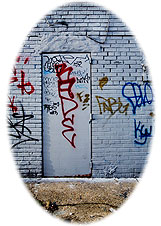How Easy is It to Be Incorrectly Identified and Targeted as a Gang Member
![]()
Understanding and Avoiding Gangs
- Are you a PARENT whose child might be involved with a gang?
- Are you a STUDENT who wants to get out of a gang?
- Do you want to LEARN more about gangs in DC?
Joining a gang or crew can give you a sense of belonging and acceptance, but often being associated with one can lead to dangerous consequences. Here are some ways to explore alternatives to gang membership and how to safely "leave" a gang if you're already involved. Some of these steps can take time, but with dedication and the support of your family, you can change your life.
What is a Gang or Crew?
A Gang is a group of individuals that band together for a common cause and are involved in criminal activity. Many gangs are highly organized and operate across state lines. A crew is a more loosely-knit group, often based on a neighborhood. These are usually individuals who grew up in or who have family roots in that neighborhood. Regardless of Gang or Crew affiliation, both groups are often associated with a variety of crimes, including narcotics trafficking, gun violations, assaults, and even homicides. Female gangs or crews are growing in DC as well. Gang violence is "a community problem." Think about it!
Who Joins Gangs/Crews and Why?
- Young people who feel they are not respected by their peers, families or communities turn to gangs for the identity and respect that families normally provide. Youth who see themselves as "weak" or "powerless" may join gangs to become "stronger" and "protected." Often these individuals suffer from a lack of support from their family and therefore seek support within the gangs.
- Young people who crave excitement because gang members and the media often glamorize the gang life style.
- Young people who cannot resist peer pressure may join because their friends are in gangs. They may feel pressured to join to be part of the "in" crowd.
- Young people who are fearful often feel that being a gang member will keep them safe. If they are challenged by others, their gang/crew will help them retaliate because in the gang culture, no challenge goes unanswered. Perversely, this idea of "safety" leads to increased violence.
- Youth who do not understand the consequences do not fully understand the risks of being in a gang. Risks include arrest, physical assault and in some cases, death.
- Young people are often recruited by older gang members to commit their criminal acts, because the adults feel that laws are more lenient on juveniles. This, however, is a misconception.
What Can Parents Do?
- Talk to your children openly and honestly. Tell them you do not approve of gangs. Explain what might happen if they join a gang. Tell them that they could be physically harmed or pressured into committing criminal acts that could result in their arrest. Tell them that they could lose their lives.
- Make sure your children are involved in healthy, supervised activities, especially after school.
- Find out where your children go in their free time. Get to know your children's friends and their parents.
- Get involved with your children's education and their schools. Encourage them to study and stay in school.
- Set limits for you children and enforce them. Tell your children they are special and you are concerned about their safety.
- Get information about the gangs and crews in your neighborhood. Find out what gang members wear and what gang signs and symbols (such as tattoos, colors, hair and dress styles, etc.) mean. Ask about gang graffiti on walls and other places.
- If you see your children wearing gang-style clothing or using gang symbols, tell them you do not approve. If you suspect your child is getting involved with a gang, take action fast. A list of places to call is on the back of this brochure.
- Make sure your children know you will help them with their problems and not judge them unfairly. Encourage them to talk to you. If they won't talk to you, ask them to talk to a relative, an older friend, their school counselor, a youth leader, your clergyman or any adult they trust.
What Can Students Do?
Be proactive.
- Tell your parents, a school counselor, or a police officer immediately if you are approached by a gang member attempting to recruit you.
- Let gang members know you respect them but you are not interested in joining a gang.
- Avoid areas where gang members hang out.
- Attend school regularly and work hard. Think about the future — what kind of job would you like? What do you have to do to get that job? If you do not like your school, talk to your family or counselor about transferring.
- Find others who want to stay out of gangs. Develop friendships with peers you trust.
Ask for help. Find a mentor.
- Find at least one adult that you feel comfortable talking to. This might be a family member, a teacher, a counselor, or a police officer. Use this person as a mentor. Talk to him or her about problems that concern you. Listen to what he or she says and be open to new ideas.
- Talk to your parents, a school counselor, or any other mentor with whom you feel comfortable. There are many community agencies that are able and equipped to assist with situations like this (see the back panel for some examples).
Be too busy to get involved.
- Remove yourself from the area. Gradually limit your involvement with other known gang members. The less you are in the area, the better. Find activities to keep you occupied and away from that area.
- Find a job in another neighborhood. Even if it is a part-time job, it will help in the process of breaking that gang connection. If a young person is busy and constructively engaged, he/she will not need the false self esteem a gang provides.
- Get involved in school activities or other community organizations. Your school counselors would be an excellent resource to these activities. Remember, "idle hands are the Devil's playground." Get involved and stay busy. There is more to life than your neighborhood or your "boys" or "girls."
Change your environment.
- Talk to your parents about moving to another school or neighborhood. In some cases, this may be necessary to remove yourself from the gang permanently by putting distance between you and your old school and neighborhood. Moving to another neighborhood may help resolve the issues.
Signs of Possible Gang Involvement
Below are some indicators of possible gang involvement, but these characteristics should not be used as the basis for assuming someone is associated with a gang or crew:
- Cutting classes at school
- Decline in grades
- Truancy
- Change in demeanor (becoming disrespectful and not obeying rules at home)
- Use of alcohol or drugs
- Staying out later than usual
- Possession of weapons
- Sudden change of dress style (more of a specific color)
- Friends of questionable character
- Pictures with friends displaying hand signs and or bandanas
- Inscribing gang graffiti on books, folders, desks, and walls.
- Tattoos in the name of a gang
Characteristics of Gangs
- Gang Attire
Gang/crew members usually adopt a certain way of dress, sometimes displaying a specific color or style. In some cases, the clothing may display gang names, member's nicknames, numbers, street names, etc. Members may also have tattoos that display the gang name, a nickname, or tattoos with hidden messages that only another gang member can read.
- Monikers
A gang/crew member usually has a nickname or moniker which also may be displayed in the form of a tattoo or graffiti. The name may highlight a street, neighborhood, or cultural term.
- Gang/crew Name
Gangs/crews usually adopt a "gang name." This name usually contains a street, neighborhood, or a cultural term. They will usually mark their neighborhoods or the territory they control with graffiti or "tags" depicting the gang name or symbols.
- Skip Parties
Gangs/crews host secret parties during school hours. Activities at these parties often include alcohol consumption, narcotics use, sex and other illegal and dangerous activities.
Download a Brochure
- Understanding and Avoiding Gangs [PDF]
Resources
- Emergency/Non-Emergency: 911
- MPD Youth Investigations Branch: (202) 576-6737
- MPD Gang Intelligence Fusion Division: (202) 724-1424
- MPD Anonymous Crime Tip Line: (888) 919-crime
- MPD Anonymous Text Message Tip Line: 50411
- District of Columbia Public Schools:Gang Intervention Unit (202) 576-5025
- Department of Parks and Recreation:Roving Leader Program (202) 673-6843
Community Organizations
- Alliance of Concerned Men
(202) 903-1002
- Columbia Heights/Shaw Family Support Collaborative
(202) 518-6737
- Latin American Youth Center
(202) 319-2225
- Peaceoholics Inc.
(202) 562-1892 or 562-1971
- East of the River (Marshall Heights) Collaborative
(202) 397-7300
- Edgewood/Brookland Collaborative
(202) 832-9400
- Far South East Collaborative
(202) 889-1425
- Georgia Avenue/Rock Creek East Collaborative
(202) 722-1815
- Healthy Families Thriving Communities
(202) 299-0900
- North Capital Collaborative
(202) 588-1800
- South Washington/West of the River Collaborative
(202) 488-7997
- Tale of the Tape Foundation
(202) 588-5857
Information provided by MPD's Homeland Security Bureau/Intelligence Fusion Division/Intelligence Section.


garlickenesuatims.blogspot.com
Source: https://mpdc.dc.gov/page/understanding-and-avoiding-gangs
0 Response to "How Easy is It to Be Incorrectly Identified and Targeted as a Gang Member"
Post a Comment